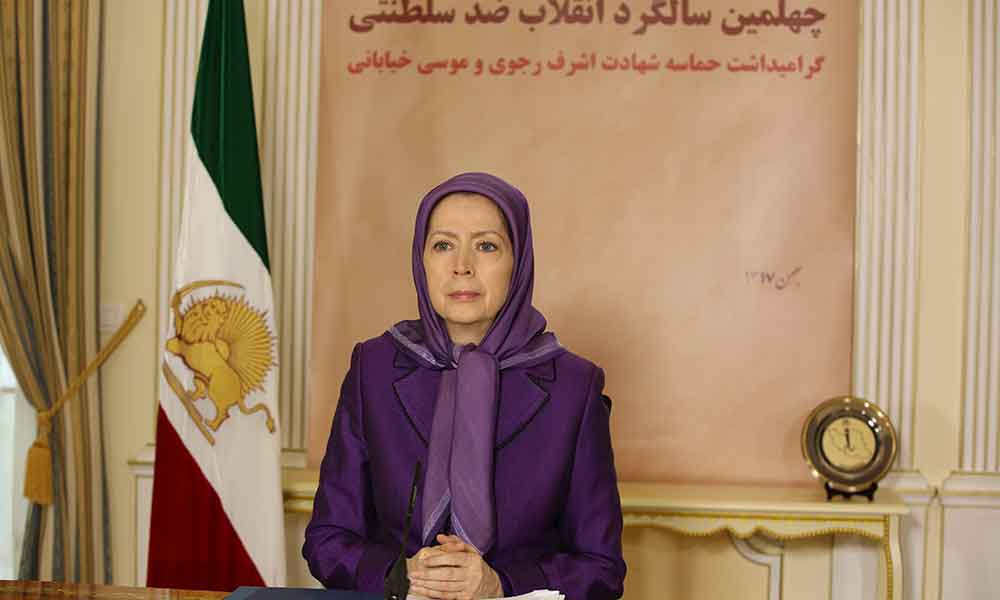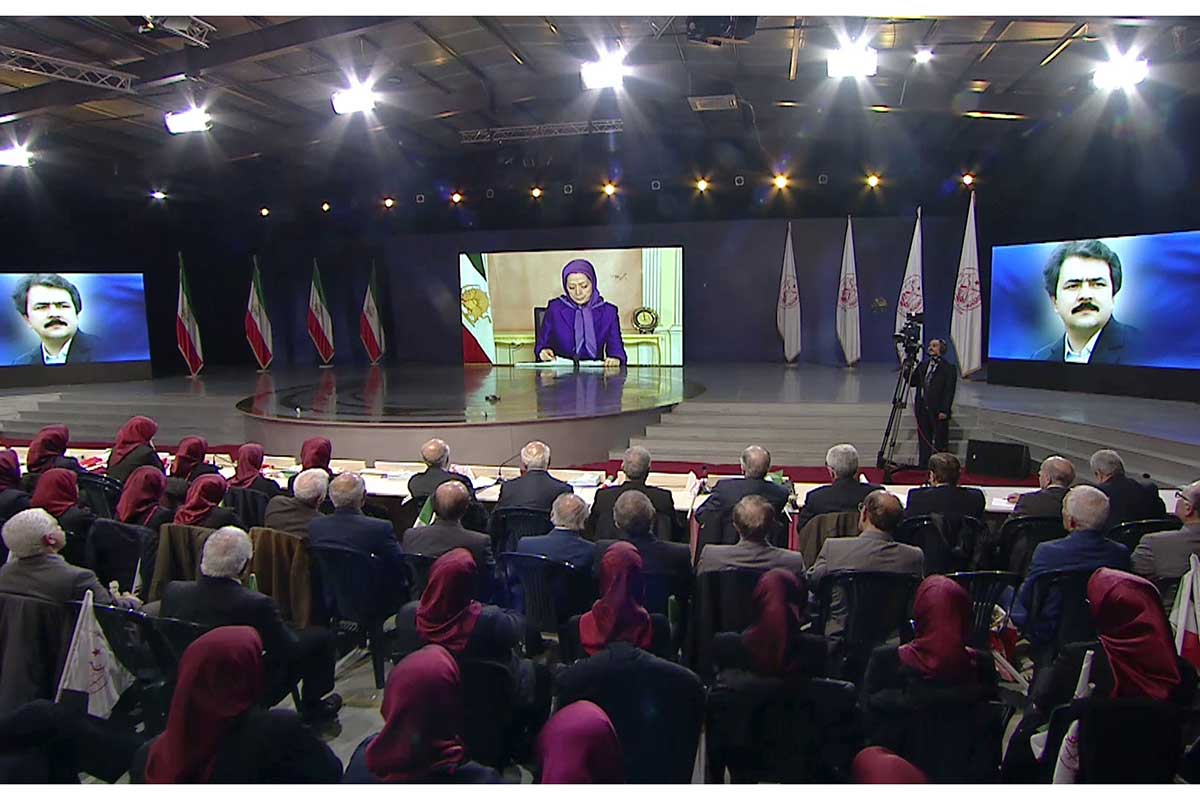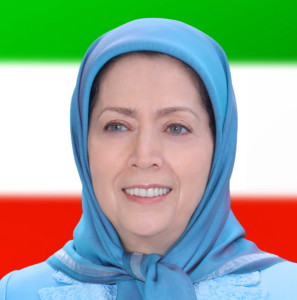Maryam Rajavi: The Shah was overthrown in 1979, now is the turn for the mullahs

Observing 40th anniversary of the anti-monarchic revolution, and commemorating February 8, 1982, martyrdom of Ashraf Rajavi and Moussa Khiabani
On the eve of the anniversaries of the anti-monarchic revolution, and the martyrdoms of Ashraf Rajavi, Moussa Khiabani, we salute the trailblazers and true leaders of that great revolution and we hail those martyred on February 8, 1982.
We also renew our pledge with them to make freedom of the Iranian people a reality.
On February 8, 1982, the people of Iran paid a heavy price. They sacrificed Moussa Khiabani, one of the most honest and most honorable leaders of the generation of young Iranians who rose up against the Shah’s regime, and exposed and isolated Khomeini after the 1979 Revolution.
Our people sacrificed Ashraf Rajavi on the path to freedom. She was a role model for a generation of women who rose up for freedom and equality.
From a political and historical standpoint, this great sacrifice showed that the people of Iran has not and will never surrender to the usurpers of the 1979 Revolution.
February 8 echoes the voice of a nation that says, ‘We had never wanted a backward regime; we did not bring down the Shah to let the mullahs take over and establish a much more vicious rule. We neither want that decadent past nor the reactionary present. We seek freedom and advancement towards future.’
We salute Asharf, Moussa, and those who died in their company, and we hail all the captive Mojahedin in Khomeini’s prisons who braved torture and execution for paying tribute to the lifeless bodies of Ashraf and Moussa.
37 years have passed, but the mullahs still tremble when hearing the name of Moussa; they are still terrified of the name of Ashraf; and they are still making fake films and stories to offset the impact of the epical martyrdom of Ashraf and Moussa.
The epic resistance of Ashraf and Moussa embodies the essence and spirit of all the fights and sacrifices of the Mojahedin since February 8, 1982 until today. It goes far beyond and above the notion of refusing to surrender.
The message of the Mojahedin –both from a philosophical-anthropological standpoint and from a historical-political point of view– is that revolutionary human beings and revolutionary movements are determinant, fate making and able to bring about change.
This is also the essence of the Mojahedin’s internal revolution which seeks to overcome all coercions and hardships. In light of this revolutionary vision diametrically opposed to the two dictatorships, the Mojahedin have been the most determinant force in Iran’s history over the past five decades.
Those who attempt to equate the anti-monarchic revolution to Khomeini’s ominous rule are distorting history. They fail to notice the truth as if Iran’s history is summed up only in dictatorships and in authoritarian and despotic regimes.
Now one must ask them, didn’t the people of Iran and their genuine representatives have any role in this history? Didn’t their revolutionary children have any concrete existence? Didn’t this nation have a revolutionary movement or force of her own? And was her history just limited to the kings and the clergy?
Indeed, what is the truth?
The truth is that Khomeini and Khamenei were the true inheritors of the Shah. Their rule was the product of western governments’ drastic mistake in their coup against the nationalist government of Dr. Mohammad Mossadeq, blocking the progress of nationalist and democratic forces and opening the way for a reactionary alternative. The clerical regime is the outcome of the Shah’s treacherous clampdown on freedom-loving movements creating a vacuum in their absence for Khomeini to fill.
Iran’s history has always seen the complicity of kings and the clergy to instate tyranny and oppression. The accomplices have always acted in harmony to plunder our impoverished people.
Similarly, today, we see that the torturers and icons of corruption in the previous dictatorship are among the hirelings serving the interests of the mullahs’ regime.
At the same time, the mullahs’ mercenaries advocate for the rule of the dead and buried monarchs. In this way, they try to project that Iran can be governed only by kings and clergies and there is no place for democracy and a republic based on popular sovereignty.
As you are aware, one of the figureheads of the August 19, 1953 coup d’etat was General Fazlollah Zahedi. Prior to the coup, he was strongly backed by mullah Abol-Qassem Kashani, a top clergy at the time. Today, his son (Ardeshir Zahedi) who was the Shah’s son-in-law, has come forward to lend support to the mullahs’ supreme leader. He paid tens of thousands of dollars for an ad in the New York Times, to defend the mullahs’ criminal policies in the region, justifying the clerical regime’s presence in Syria as being on the invitation of a legitimate government(!) and an independent country(!).
Another scandalous example is a book published a few years ago, by one of the Shah’s key henchmen, Parviz Sabeti. The book is apparently about his services to the Shah’s dictatorship but originally aimed at distorting the image of the Iranian Resistance, especially its leader, Massoud Rajavi. The most noteworthy aspect of the book is that Sabeti was interviewed by a notorious agent of the clerical regime’s terrorist Qods Force.
Another fact about the 1979 revolution is that it was brought about by the long-time struggle, suffering and sacrifices of Iran’s freedom fighters The People’s Mojahedin Organization of Iran, the People’s Fedaii Guerrilla Organization, and other freedom-loving forces made great sacrifices to sow the seeds of revolution in society and in Iranian history. Just as Father Taleghani said about the PMOI founders, “They opened the way for that struggle.”
Those remembering the events of those years recall that right after being released from prison on January 20, 1979, Massoud (Rajavi, the leader of the Iranian Resistance) publicly drew the lines between the political and ideological views of the Mojahedin and those of Khomeini and his reactionary entourage, in the very first speeches he made even before the victory of the revolution.
Only three days after he came out of jail, that is on January 24, 1979, Massoud made a speech at Tehran University. Contrary to Khomeini who advocated “Islamic Revolution” – which was another dictatorship under the banner of Islam—Massoud explicitly spoke of and earnestly defended “the Iranian people’s democratic revolution.” Speaking of “democratic revolution” in those days required utmost courage and audacity in those days.
In the early days after the victory of the 1979 Revolution, Massoud made speeches again at Tehran University and in a huge gathering in Ahmadabad on the anniversary of the demise of Dr. Mossadeq. In these speeches, he clearly outlined the positions of the Mojahedin and exposed Khomeini’s taking advantage of the notions of Islam and revolution.
On April 26, 1979, only two and a half months after the revolution, Massoud Rajavi, Moussa Khiabani and a delegation from the Mojahedin met with Khomeini. Massoud read parts of Sermon 207 from Nahjol Balagheh to Khomeini in which Imam Ali (the first Shiite Imam) told people, “Do not talk to me as you talk to dictators and oppressors. Do not hide from me what you hide from those who rule by violence and terror. And do not use flattery in speaking to me.”
One can tell how difficult it was for Khomeini to tolerate these words in the days when he enjoyed his maximum power.
Later, in the interviews Massoud did in 1980, he listed Khomeini’s reactionary policies and positions, and one by one explained, placidly and firmly, the deep differences between Khomeini’s outlook and that of the Mojahedin.
So, one can see that since the outset, the Mojahedin have stressed on the confrontation of two totally different versions of Islam in Iran.
I would like to quote part of that interview: “Today, not only the people of Iran, but the people of the world know that there are two totally different versions of Islam lined up against each other in Iran. So, in future, no one (here) nor anybody with any other belief in other parts of the world would be able to attribute the (clerical regime’s) monopoly of power, murders, torture, stoning, flogging, and trampling of rights to genuine Islam.”
Massoud did warn Khomeini about his responsibility in issuing orders to slaughter and crack down on the Mojahedin by these words: “The leader who refused –until the final years and final moments (of the Shah’s regime)– to issue any fatwa for struggle and Jihad against the Shah, issued his fatwa in the first years after the revolution sanctioning opening fire on the Mojahedin who had fought the Shah for years but had not fired a single bullet under the new regime. This is how bloodshed picked up new heights all across the country.”
A review of the Mojahedin’s positions and the interviews and speeches by Massoud Rajavi in the 2.5 years after the 1979 revolution clearly shows that the Mojahedin demonstrated the maximum possible patience, sobriety and sense of responsibility to postpone Khomeini’s onslaught. Were it not for the responsible and selfless role played by the Mojahedin, and their restraint despite the regime’s murder of 54 of their members, Khomeini would have eliminated the limited remaining freedoms much sooner.
It is also important to note the reality that Khomeini was a monster who in those days could eradicate any force or group just by giving a signal. In such circumstances, however, the Mojehedin launched a major revolutionary movement with amazing resilience based on honesty and sacrifice. This movement managed to remain steadfast against the tsunami of slaughters and massacres and turn into an enormous asset for the people of Iran in their quest for freedom.
Massoud Rajavi led the People’s Mojahedin Organization through fire and blood in the first two or three years of Khomeini’s rule.
Our organization faced horrendous ideological and political obstacles, each of which was enough to terminate any movement as attested by quite a few similar cases in modern history. Yet the revolutionary, trailblazing, effective element that brought about change was Massoud Rajavi’s leadership. He led our organization and removed the obstacles on the path of freedom for our enchained nation.
Yes, obstacles and hardships are always there. They are real, but the art of a revolutionary is to not give in to reality, and instead change it in favour of the liberating goals and in the interest of his people. This is the tradition, the manner and the practice the Mojahedin have learned from Massoud.
Dear sisters and brothers,
We talked about the overthrow of the Shah’s monarchy. Now is the turn for the overthrow of the Sheikhs from their throne.
You know that Khamenei has called on his mercenaries to be ready for countering the regime’s overthrow in the coming Iranian year 1398. Since then, the regime’s factions have been scaring one another of the prospect of the regime’s overthrow by stressing on Khamenei’s warning.
The regime’s Friday prayer leader in Mashhad said, “Our war with the enemy is over our existence. Our enemies want to see us beheaded.”
The Friday prayer leader of Qom said, “We must be on full alert to be able to safely get through the crises ahead of us.”
The commander of Bassij in Iranian universities said, “The year 1398 will be an educational workshop for confronting the riots by (the Mojahedin).”
The regime’s Friday prayer leader in Tehran said, “The enemies are arrayed to overthrow (the regime) … They are targeting the Supreme Leader.”
Yes, this is the whole issue, “arraying to overthrow the regime.” The whole issue is the Iranian people and Resistance’s “targeting of the supreme leader.”
This is why the mullahs keep shaking from fear. They are on the watch round the clock to prevent the situation from getting out of hand, and this is one of the regime’s most vulnerable soft spots. They say they are on full alert in a bid to cover up the regime’s faltering condition.
There are several significant points to be noted in this regard:
First is the fact that such helplessness, inconsistency and haste in the regime are direct consequences of the new era. For example, in circumstances when the mullahs need most to get along with Europeans, why do they task their diplomats with terrorist operations in the heart of Europe? Why are they not able to meet the requirements of the FATF? Why can’t they find a political solution for the crises besetting the regime? All of these are because the Velayat-e Faqih regime faces the de facto threat of being overthrown.
Second, the mullahs are not capable of containing the social uprisings and protests. They have no way out of this deadly impasse. As Massoud had predicted, “The mullahs and their IRGC will not be able to overcome this victorious uprising and regardless of the ups and downs, they will not be able to get away with it.”
Third, in addition to social protests, the regime faces economic devastation. The country’s 40% inflation is on the rise while the value of the country’s official currency has slid by 66 per cent in the past ten months. Production units have been widely closed down producing a giant wave of unemployed workers, a budget deficit of at least 50%, and many similar problems. This is why the regime’s president recently acknowledged, “The country is experiencing the worst economic situation in the past 40 years.”
Five years ago, Rouhani pulled out a key from beneath his own and Khamenei’s cloak to offer a temporary relief to these problems. That was the JCPOA and the aid that came with the Obama Administration’s policy of appeasement. Now, the policy of appeasement has gone up in smoke, leaving the mullahs defenseless.
Fourth, since last November, the United States started imposing their oil sanctions against the regime, thereby cutting the mullahs’ lifeline. Thus the Iranian regime’s relations with the U.S. have entered an unprecedented fate-making phase.
The U.S. Secretary of State stipulated that the time has come for confronting the mullahs and stop coddling them. The U.S. National Security Advisor said the time for safeguarding the regime is over. Without the protection and safeguard the U.S. provided for three decades, the mullahs have been left seriously vulnerable before the Iranian people and Resistance.
Fifth, as far as it concerns the regime’s relations with other governments, Khamenei and Rouhani had tied their hopes to the European Union. But the EU recently imposed sanctions on a major department of the notorious Iranian Ministry of Intelligence… Germany also banned flights of Mahan Air for its ties with the terrorist Qods Force.
The regime’s Supreme Leader believed that by turning their sights to the East, they could enjoy some support in the international politics.
Now, Russia says they do not consider to be an ally of the regime. China has already left the South Pars Gas Field, and despite its previous promises, it is not going to cooperate with the regime to build its power plant in Arak. Even the government of Iraq which has well-known relations with the Iranian regime, has declared that it would participate in the international sanctions.
And finally, a new generation of determined, aware and motivated youths who have risen to fight the regime and all its factions, is the danger that shakes the pillars of Khamenei’s Palace every day. This is the generation of the December 2017-January 2018 uprising whose resolve has culminated in the formation of resistance units and 1,000 Asharfs or bastions of freedom.
The Resistance Units have grown like tulips from the blood of heroes unjustly spilt on February 8, 1982, the blood of 120,000 martyrs and the 30,000 who were sent to the gallows and massacred in summer 1988, the blood of martyrs of the National Liberation Army and Eternal Light Operation. The seeds sown during 14 years of steadfast perseverance in Ashraf, have now grown in the thirsty soil of Iran, setting up thousands of Ashrafs all across the country.
This is the grim will which gave rise to the Resistance Units and will finally topple the mullahs’ theocracy, hand in hand with the people of Iran.
Hail to Freedom
Hail to Ashraf, Moussa and the martyrs of February 8, 1982
Hail to the selfless trailblazers of the anti-monarchic revolution
Hail to Freedom

- Tags: Massoud Rajavi, MEK, Mojahedin, mullahs' regime

